Nature
Notes 2000:
Shoreham-by-Sea
& the Lower Adur Valley
*
If the grid references are not given they could be found on the
Adur
Wildlife database on the Adur
eForum
LINK
TO NATURE NOTES 2001
28
December 2000
The
ground temperature falls below freezing for the first time this winter
and the roads were very slippery.
25
December 2000
Christmas
Day
A
cold north-east wind brings the first chill to the winter after the
clement but very wet autumn. There was no sign of snow.
December
2000
First
reports of the effects of the floods in the Adur estuary, Sussex.
Carp,
Cyprinus
carpio, a freshwater fish, up to 3.5 kg
have been caught alive in the freshwater surface of the swollen River Adur
next to Monteum fish merchants, five miles downstream from the weir near
Partridge Green that separates the tidal estuary from the freshwater reaches.
The Carp were still alive. The
salinity in this area
at high tide is usually 3.2% and upwards compared to the sea at 3.4%. Freshwater
fish have never been seen (except for 3-spined Sticklebacks) in this area
before despite extensive (every day for 10 years) observations. Salinity
has also been measured quite often and rarely is the amount of fresh water
sufficient for freshwater fish, although previously, the estuary became
too fresh for marine fish and for an hour at a low spring tide, thousands
of marine fish jumped out of the estuary by Soldier's Point on a memorable
occasion.
(Cynics
should not that the local Hungarian population eat Carp
as a Christmas dinner.)
PS:
A discussion on 3
June 2007 with Mick
(an angler) near the Cement Works said that
Carp,
Roach
and
Bream have all been occasionally caught
in the tidal reaches of the Adur estuary
as near the sea as the inlet by Cuckoo's
Corner.)
18
December 2000
A
Jay
flew amongst the bare branches of the broadleaf trees in Kingston Buci,
with an acorn in its mouth from the Holm Oaks on the edge of the Shoreham
College playing fields.
About
50 Great Black-backed Gulls
roost on the Adur mudflats in the centre of Shoreham, between the Norfolk
Bridge and the Footbridge, as
is normal during the winter months.
Sea
Heath, Frankenia,
was recognised for the first time* in 2000,
from Widewater in an area west of the bridge
that had previously been fenced off to the public to protect the breeding
area of the Ringed Plover. A large patch of this plant was discovered.
This plant is very rare in Sussex known only from Rye Harbour and Chichester
Harbour, but it has possibly been missed on the fringes of salt-marshes.
The
plant has just been identified and its location is now right on the edge
of the flooded lagoon.
PS:
A similar plant is available at Garden Centres, but the possibility that
this batch is a garden escape has been rejected. *
Sea Heath is on the "Flora
of Shoreham-by-Sea" wild plant list by Betty Bishop.
(Link
to) Widewater Page (Ray Hamblett) including a photograph of the Sea Heath
13
December 2000
It
has hardly stopped raining since the beginning of September. However, the
continual steady rain of the last two days was depressing. The three months
of rain have waterlogged the ground and built up the water table. The River
Adur is on flood alert.
National
Floodline, Tel: 0845 988 1188
3 December
2000
A
flock of over 200 Crows
congregated over the northern part of the Dovecote estate (TQ
218 063) Shoreham. There was also a Kestrel.
30
November 2000
A
Kestrel
was
hovering over the grass to the east of the bridge over Widewater,
and swooped down quickly, but it quickly rose again so the strike must
have been unsuccessful.
22
November 2000
A
storm of short duration (two hours) occurred before dawn, with thunder
and lightning battered large hailstones vertically crashing against the
window panes.
17
November 2000
The
winter months are not all that productive on the strandline
of Shoreham beach, even after storms, as the sea scours the shingle
beach and takes the deposited marine remains back out to sea and increasingly
eastwards with the longshore drift.
Scattered amongst the weed there were the omnipresent Slipper
Limpet shells, with more Oyster shells than normal and the battered
remains of Lobster, Spiny
Spider Crabs, and the inevitable cuttlebones.
All were of the Common Cuttlefish, Sepia officinalis. An egg case
of the Thornback Ray
was blown inshore and a fully intact Lesser
Spotted Dogfish had not yet been spotted and scavenged by the gulls.
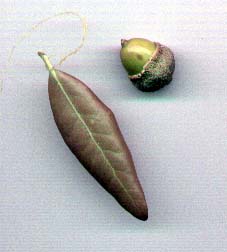 16
November 2000 16
November 2000
I
saw a single Jay
feeding on the acorns the evergreen Holm Oak in St. Mary's Churchyard,
Shoreham-by-Sea, for the very first time this century in the centre of
the town. A Grey Squirrel simultaneously
made a leap of over twice its body length from the neighbouring broadleaf
tree.
A
solitary young Greenfinch seemed out of of place in Brunswick Road.
The
fields of New Monks Farm Lancing, were still very damp with a few puddles.
15
November 2000

Cuckoo's
Corner is a layby a half mile so down
the Coombes Road from the A27 turn off for Lancing College and the Sussex
Pad. It has a collection of old trees which provide a magnet for birds.
A flock of about 50
Long-tailed Tits were singing in the lower
branches of the ivy-adorned 12 metre + high trees. This bird is not a titmouse
at all and is appreciably smaller than a Pied Wagtail, they actually
looked much smaller (apart from the long tail) than the Wrens
which
all shared the branches, and there was a Chaffinch
in the understory of evergreen vegetation.
The
floods had receded considerably apart from large puddle in the Ricardo
Test Bed field.

13
November 2000
The
Sparrowhawk
that has taken up residence centring on Gordon Road, Shoreham, and feeding
along the railway line and in the Middle Road allotments seems to have
displaced the Kestrel
that has been a regular for at least 10 years. (This
report is part hearsay, as I have seen the hawk but never close enough
to be sure of its identity.)
9 November
2000
One
Crow
amongst
a flock of at least 25 birds on
Kingston Beach,
between the second and third groyne from the west, repeatedly dropped a
mollusc of some sort on to the shingle beach. I doubt if it has had much
success. The usual dropping area (but this may be gulls) is on the concrete
near the Life Boat Station, which is sometimes covered with mussel,
cockle
and winkle shells.
8 November
2000
About
a thousand Lapwings inhabit
the mud flats near the Toll Bridge
at low tide, together with Redshanks,
Black-backed
Gulls, and thousands of Black-headed
Gulls, but these numbers are not exceptional
for the Adur.
All
the streams running off the Downs are in full flood, but they have been
as swollen as much before in January during the last 20 years. A Heron
wades in the flooded fields near Lancing College. Mash Barn is is also
flooded in parts but only to a depth of a few centimetres. The A27 near
the Sussex Pad is closed to all vehicles and is completely under water
to car bonnet depth in places.
November
2000
WORLD
OCEANS DAY 2001 will be represented at the Adur Festival Steering Group
meeting on 20 November 2000
so please send any ideas, suggestions etc. before that date to Andy
Horton.
5-6
November 2000
Steady
rain starts but locally it is not exceptional and the minor disruptions
in the Adur district are scarcely worth a mention when compared to the
flooded villages, towns and cities in the other parts of England &
Wales, e.g. Uckfield town centre in East Sussex is again flooded to a depth
of over a metre.
Local
Climate notes
2 November
2000
Mid-afternoon:
one of the brightest and most spectacular Rainbows
I
have ever seen formed a complete semi-circle over the Downs amongst the
low black rain clouds. It looks like mini-Tornado weather and three rain
and storm squalls of sufficient ferocity to make driving hazardous occur
in the afternoon. The squalls only last for five to ten minutes, and then
the gale reverts to a steady Force 7.
The
highest gust was recorded on Shoreham beach at 63 mph. This is Storm Force
10.
Shoreham
Beach Weather History 2000 et. seq.
Beaufort
Scale (sea)
30
October 2000
Decomposed
Cetacean
A
four metres long decomposed cetacean, minus its head (according
to David Wood) was washed up on Shoreham
Beach, near the Old Fort, and then quickly washed out back out to sea
by the heavy waves in the aftermath of the storms (still a steady Gale
Force 7).
Dr
Gerald Legg, Booth
Museum of Natural History, Brighton has positively identified it as
a Long-finned Pilot Whale, Globicephala melas, (Family: Delphinidae).
BMLSS
Cetacea
Sussex
Cetacea
Hundreds
of Cuttlebones, Sepia officinalis, were
also washed up on the strandline.
27-28
October 2000
Strong
(blustery) south-westerly winds (Force 6) combined with high spring tides
(to 5.8 metres) pound the shore.
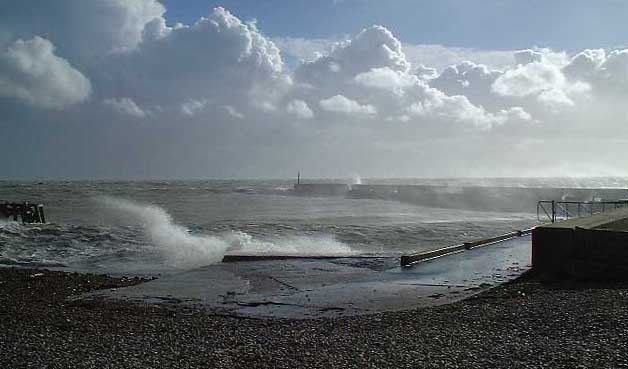
By
29
October 2000, the winds had gusted to Gale
Force 8 and even Storm Force 10, with squalls of heavy rain. A mini-Tornado
caused a great deal of damage at Bognor Regis and on 30
October 2000 another one hit Selsey. Severe
Weather Warnings are published throughout Britain with the worst weather
since the October storm of 1987. The
River
Adur is on Flood Alert.
National
Floodline, Tel: 0845 988 1188
Weather
Forecast
The
rainfall total on Shoreham beach for the whole of October was recorded
at 165 mm. It rained on 25 days during the month.
Meterological
Office: Extreme Weather
The
highest wind speed for October and the whole of the year was recorded on
28
October 2000 on Shoreham beach at 71 mph.
This is Storm Force 11 (nearly Hurricane Force).
Shoreham
Beach Weather History 2000 et. seq.
Beaufort
Scale (sea)
Beaufort
Scale (land)
 26
October 2000 26
October 2000
Portuguese
Man o'War, Physalia physalis,
are
discovered washed up on the Sussex coast at Brighton. This has happened
before, but not in the last 20 years. Although, there were no reports from
Worthing, Shoreham or Southwick beaches, these siponophores (colonial hydrozoans)
breed to the south-west of Britain off Portugal and they must have been
blown through the seas off Shoreham before they were stranded at Brighton.

October
2000
Mushrooms
(Fungi) are fruiting under the beech trees of Lancing Clump, meadows, churchyards
and other waste spaces.
22
October 2000
The
British Trust for Conservation Volunteers (BTCV) and other helpers embarked
on the physical management of the Larkfield Paddocks at Lancing.

The
marginal and mud dwelling Celery-leaved
Buttercup, Ranunculus
sceleratus, is poisonous to touch
and is capable of producing blistering sores to the skin. A single plant
is on the edge of the Paddocks' Pond.
As
far as I know, this plant is rare or scarce in the Adur
Valley, but in the Arun or Ouse Valleys,
Sussex, it is common in a few places if you know where to look for it.
Link
to the Report on the web page by Ray Hamblett
20
October 2000
Kingston
Beach:
A
low neap tide after
a period of heavy rain in late autumn is usually very poor for mobile intertidal
life on the Sussex coast. However, in the pool under the groyne, there
was an adult Blenny, and juvenile Corkwing
Wrasse (one) and juvenile Bullheads
(4+). One of the Bullheads was rusty-coloured,
but this disappeared in captivity. The sea still covered most of the shore.
17
October 2000
As
the leaves fall, the occasional glimpse of the red breast of the Robin,
and the red face of the Goldfinch
stands out amongst the muted hues. Goldfinches
are also frequently seen in the "unofficial countryside" in charms (or
chirms) of about 5 birds. Charms of larger numbers (up to about 10) contained
juveniles without the facial markings. The Adur
is flooded by the spring tide and swollen by the recent rain, so the hundreds
of Lapwings
forsook the mudbanks which are covered by water to settle on the airfield.
Herons
are plentiful enough to be sure to be seen on the Adur
flood plain.
There
are still scores of House Martins
around, notable flying to and fro over the Widewater
margins.
13
October 2000
There
was very little evidence of the rain of the last two days, Even Widewater
Lagoon had not risen to a flood warning extent, although all the flood
plain was sodden. The white faces of five Coots
on the lagoon were immediately noticeable on a sunny shirt-sleeves day.
These birds, in the 1970s were frequently seen on the Adur
estuary had declined in recent years and were sometimes absent altogether.
However,
my attention was quickly distracted by a colourful male Kestrel
taking off from a stump or a patch of dryish grass to the east of the bridge
over Widewater, and flew west so it was hidden by the Tamarisk bushes.
Lapwings
and Redshanks
returned to the sand banks and edges of the Adur.
On the east bank between the Toll Bridge
and the Railway Viaduct (TQ
210 054), a leucistic
(white upper-winged) Magpie
was
seen briefly. This bird has been around for several years, but this was
the first time I had seen it this year. (It looks like a Seagull, but flies
like a Magpie.)
11-12
October 2000
Thunder
& lightning, gales and squalls of heavy swirling, sometimes torrential,
rain continuously for over 36 hours; this dreadful weather (worst in my
memory) occurred over most of Britain, but it was worse in the south. The
B2135
road between Steyning and Partridge Green was closed due to flooding both
ways as the River Adur burst its banks.
On
12 October 2002 an
incredible rainfall total of 53.8 mm was recorded on Shoreham beach.
Shoreham
Beach Weather History 2000 et. seq.
Meterological
Office: Extreme Weather
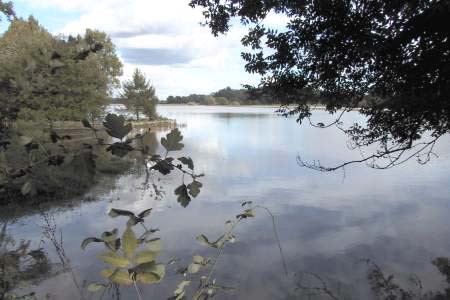
The
flooded River Adur at Mock Bridge near Shermanbury
Photograph
by Allen Pollard
(The
River
Adur flooded at Bramber in 1904)
In
other parts of Sussex, e.g. Uckfield High Street, the floods were over
a metre deep (over 160 mm rain).
Flood
Reports (Meridian TV)
National
Floodline, Tel: 0845 988 1188
Shermanbury
Flood Images (by Allen Pollard)
Meterological
Office: Extreme Weather
9
October 2000
Start
of the bad weather, with heavy rain continually throughout almost the whole
day (about 30 mm).
Local
Climate Details
7 October
2000
The
Pied
Wagtails are back in their normal winter
numbers, bathing in the steady rain on the town streets
of Shoreham.
The
post-equinoctial neap tides only vary between 4.0 metres and 1.9 metres
(springs can vary from 6.7 metres to zero above Chart
Datum).
5 October
2000
A
sunny day with the occasional brief shower, and the Clouded
Yellow Butterflies were still around.
I saw one on Shoreham beach and one at Lancing where I
first discovered one this year.
A
Little
Egret was feeding in the
cockle lagoon
(to the west of the bridge), part of Widewater Lagoon.
I had not seen one on the River Adur (estuary)
this year, but the young
Bass shoals were not
as numerous as in the special year 1999. The first few Goldfinches
and Greenfinches returned to the fringes of the lagoon. Immigrant
Black-backed
Gulls (from Scandinavia) began to roost
on the Adur mudflats and congregated on the tops of warehouses, with 50+
near the houseboats with a solitary
Heron
and a handful of Cormorants.
2 October
2000
An
adult Butterfish was caught amongst the
small prawns and an adult Bullhead under the
groyne at mid-tide level on Kingston Beach.
At least one Shore Crab was infected with the
parasitic barnacle Sacculina
carcini.
A
Hairy
Crab was also noted.
At
least 30 Crows
foraged on the shingle as the tide came in. A mixture of gulls, including
at least one mature Herring Gull
stood and foraged on the small portions of remaining sand.
29
September 2000
The
sea had churned up the sand at Kingston Beach,
where the fauna was scanty, but notably an absence of large prawns.
Adult Corkwing Wrasse (one), large first
year Corkwing (only one caught in an upper pool underneath a groyne) but
more would be present, large 5-Bearded
Rockling (one was 18 cm in an upper pool), Bullheads
(in the upper pool to 95 mm) and small Rock Gobies
were very frequently discovered under rocks.
24
September 2000
Ball
Lightning was reported from Franklin Road, Shoreham, by Peter
van Doorn, during a brief thunderstorm.
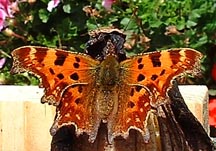
A
second generation Comma Butterfly,
with fewer yellow markings on it's wing edges, visits a garden in Lancing.
Captain's
Butterfly Guide
22
- 23 September 2000
At
least 50 sightings of Honey
Buzzards have been reported between Beachy
Head and the Arundel Wildlife & Wetlands Trust Reserve. It was at the
latter location that several of these migrant birds of prey from continental
Europe were seen soaring together. Reports from the Adur
Valley over the years have been restricted to a few solitary birds,
with two passage records over Worthing in June 1985 & 1986.
Honey
Buzzards Information Page (Surfbirds)
Ralph
Hollin's Nature Notes (Hampshire Records)
Hawk
Conservancy (Honey Buzzard)
Sussex
Records
Honey
Buzzard Facts
Immigration
Report 2000
21
& 23 September 2000
In
light rain and low cloud on both days, in a moderate southerly breeze occasionally
gusting to near gale, I came so close (2 metres) to low flying female
Sparrowhawks whilst cycling, I thought
we going to collide, but this bird of prey's superior eyesight enabled
to soar quickly out of the way. The first near collision occurred on the
cycle path by Widewater Lagoon (TQ
196 040) and the second one just north of
Shoreham railway station (TQ 218 053).
The blunt dark-brown and very broad forehead of this bird was particularly
noticeable and it looks a much bigger bird close-up.
Identification
Notes
More
Information on Sparrowhawks
Sussex
Bird Records
 September
2000 September
2000
Fungi
(especially the large mushrooms, large enough for eating) needs more precise
identification than most of the wild plants and animals. Test your identification
by the clear and colourful photographs on Ray Hamblett's:
Fungi
of Lancing Ring
15
September 2000
The
rain has finally arrived, with squalls throughout the afternoon, and thunder
with torrential rain in the evening. Chris
Alcott spotted a Waterspout/
Tornado off the Shoreham coast. Small
tornadoes are commoner than expected off the Sussex coast in the autumn.
 14
September 2000 14
September 2000
A
clump of Ivy on the riverside of the old railway track path south of the
Toll
Bridge on the east side of the River Adur at
Shoreham was covered with Red Admiral Butterflies,
well we counted twenty in a two metre square area. The most I've seen in
one place this year. TQ 211 054,
is about the spot, We also saw one Comma
Butterfly,
(it's markings were of the first brood) and one Clouded
Yellow.
By
the late afternoon the Red
Admirals had restlessly settled on the
large Ivy Bush in the same numbers and they were joined by a handful of
Painted
Lady Butterflies and a Common
Darter Dragonfly.
This Ivy Bush was also attractive to honey bees, hoverflies,
bumblebees
and weevils.
Butterfly
Conservation Society
UK-Leps
eForum (Lepidoptera)
Ceri's
Butterfly Page (with pics)
12
September 2000
 A
few female Common
Blue
Butterflies
were seen near Beeding Hill. A
few female Common
Blue
Butterflies
were seen near Beeding Hill.
Common
Blue Butterflies on chalk (link)
Captain's
Butterfly Guide
Three
or four species of Dragonflies hawked/darted
over the Downs. In order of frequency, they appear to be (subject to confirmation):
Emperor
Dragonfly (frequent 30+) Anax imperator
(Some
of these could have been the Migrant
Hawker, Aeshna mixta on reflection.)
Common
Darter
(frequent
70+) Sympetrum striolatum
(Some
were
blue-grey the others orange-brown)
Some
could have been the Ruddy Darter, Sympetrum
sanguineum ?
British
Dragonfly Society
After
harvest, the Skylarks forsook
the arable fields for the scrub by the side of the road (near Mill
Hill).
11
September 2000
Humming
Bird Hawk-Moth, Macroglossum stellatarum.
The
first one I have seen this year appeared here my garden in South Lancing,
it hovered briefly on the flowers of Verbena bonariensis and Common
Lavender. And the Great Tits
have started to use the Hawthorn tree. Dozens of Garden
Spiders, Areneus diadematus, are
now decking the garden with large spun webs.
More
Information from the Garden
Spiders
of North-West Europe
On 23
September 2000 another one of these attractive
moths was seen on the Lavender bush in Dave Mason's front garden just north
of Shoreham railway station.
Picture
from Cornwall (Link)
 10
September 2000 10
September 2000
A
really hot and humid couple of days up to 25° C, as hot as any day
of the year brings the larger butterflies like the Clouded
Yellow, Red
Admiral and Painted
Lady Butterflies, Cabbage
Whites, back on the wing. Scores of House
Martins swooped over the Downs.
The Lapwings
returned, settling on the arable fields next to the river and north of
the airport.
A
man walking his dog reported a Kingfisher
in an oak tree in the field opposite Beeding Cement Works.
7 September
2000
Birds
are on the move all over the Adur area, with a flock of about 50 Wheatears
flying over the beach next to Widewater prior
to their southerly migration. The lagoon was hosting 30 Mute
Swans. Under the overcast sky the stiff
breeze gave confirmation of the end of summer, and on the estuary
the arrival of 60 Greater Black-blacked
Gulls gave them mastery of the mud bank.
At least 30 (counted) Crows congregated
on the roof of a house in Corbyn Crescent, Shoreham, and make a din. Flocks
of over 100 Crows can be expected on the farming land north of Shoreham.
4 September
2000
Air
Show
Several
thousand House
Martins swooped to and fro over Shoreham
Beach in an acrobatic prelude to their annual migration to warmer climes.
By the following day they had all left.
31
August 2000
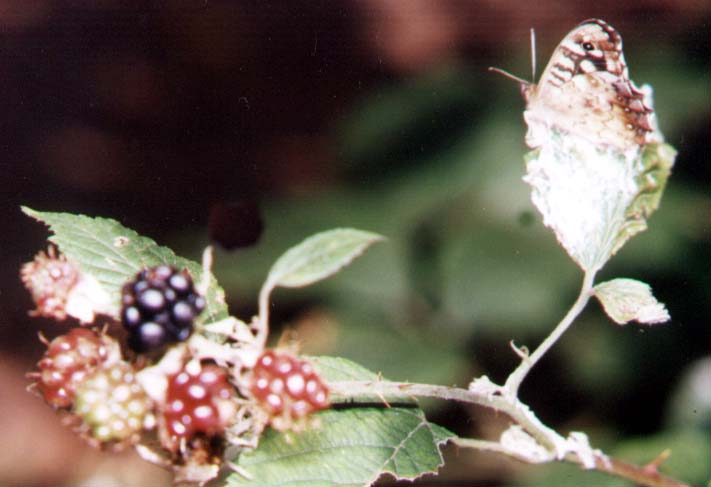 Blackberry
Picking Time Blackberry
Picking Time
Mill
Hill has scrub and trees to the north of the grasslands (TQ
210 075) giving a variety of habitats in a
small area. Nothing like the woodland on Lancing Clump, but enough to support
a Speckled Wood Butterfly.
Emperor
Dragonflies
are really a large impressive
insect hawking the Waterworks Road (TQ 210
064).
August
has been dry with scarcely any rain for the whole of the month during daylight.
30/31
August 2000
On
some of the lowest tides of the year, Kingston Beach
was full of marine life, although nothing exceptional. Long-legged
Spider Crabs were common and the intertidal fish included Rock
Gobies, Common Gobies, Bullheads,
Blennies,
Corkwing
Wrasse (juv.), Butterfish,
Ballan
Wrasse (juv.), 5-Bearded Rockling and an
Eel (in order of prevalence).
Full
Species List
29
August 2000
A
Worm
Pipefish,
Nerophis
lumbriciformis, was discovered under an Enteromorpha
(green
seaweed) covered rock 15 metres to the east
of Worthing Pier. This came as a complete surprise
as I have never seen this fish on Sussex shores
before, although there is a record in the MERMAID
database.
Database
Report
27
August 2000
The
1987 Great Storm denuded so many of the trees in Buckingham Park, Shoreham,
that the habitat for woodland life has still shown no signs of recovery
and it is not likely to because there are no new trees being planted. The
most numerous butterflies were the frequent Red
Admirals. One butterfly seemed inclined
to return to the same area, on the grass path between the large beds of
nettles, after being disturbed. There must be quite a few smaller insects
because four Emperor Dragonflies
were on patrol.
However,
a few trees have been planted on the virtually impassable narrow Beech
& Sycamore trail along the southern edge of the A27 by-pass from the
top of The Drive, Shoreham to Slonk Hill Farm Bridge, where the Speckled
Wood Butterfly
(pic) was the first record in the
Shoreham boundaries on these web pages.
24
August 2000
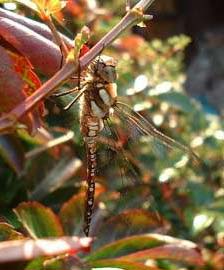 Under
the dark Beech canopy of Lancing Clump, Speckled
Wood Butterflies (pic),
fluttered
around in pairs and landed and opened the wings only too briefly on brambles,
ivy and other greenery. There were dozens of them and it was hard to estimate
their numbers because they were well camouflaged when resting with their
wings closed. They were present on the more open paths as well. Under
the dark Beech canopy of Lancing Clump, Speckled
Wood Butterflies (pic),
fluttered
around in pairs and landed and opened the wings only too briefly on brambles,
ivy and other greenery. There were dozens of them and it was hard to estimate
their numbers because they were well camouflaged when resting with their
wings closed. They were present on the more open paths as well.
An
Emperor
Dragonfly hawked to a from over the Dew
Pond on Lancing Clump, with the dragonfly (or damselfly) in the photograph
by Ray Hamblett,
which we have not positively identified yet. This species seems to be common
and has been reported over garden ponds in Shoreham. This species is most
probably the Migrant Hawker,
Ashna
mixta. Another Emperor
Dragonfly was seen in Sompting.
Friends
of Lancing Ring
Ray
Hamblett's Lancing Chalk Pit page
British
Dragonfly Society
23
August 2000
A
Painted Lady Butterfly
settles on a Common Fleabane
(yellow flower) adjacent to Widewater Lagoon.
The lagoon had fallen in level considerably under the scorching sun
of August.
Ray
Hamblett's Widewater page (with photographs)
Widewater
Lagoon Information Page (link)
Clouded
Yellow Butterflies fluttered
around everywhere and are too numerous to rate a mention now. The average
count without looking them in the second half of August was 30 a day in
Shoreham-by-Sea and its environs. They never settle and open up their wings.
22
August 2000
A
flinty path leads from the top of Upper Kingston Lane to Southwick
Hill under which the main A27 road burrows a large tunnel which is
hardly noticeable from the vantage point 121 metres above sea level. A
few would not settle in the strong breeze, but a handful of Adonis
Blue Butterflies (identification confirmed)
settled.
Meadow
Brown butterflies were frequently seen.
Blue
Butterflies
A pretty
little Small Copper Butterfly
fed on a yellow flower on the path * going downhill east from Southwick
Hill towards Mossy Bottom and up to New Erringham Farm and Mill
Hill. It was harvest time and a pleasant sunny (22° C) day without
the excessive humidity of late.
An
Emperor
Dragonfly hawked at the top of the hedge
at the junction of the road from Mill Hill to New Erringham Farm * .
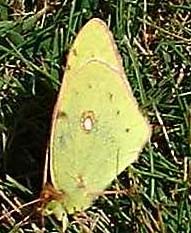 20
August 2000 20
August 2000
The
immigrant
Clouded Yellow Butterflies are now common
(100+) near Shoreham Airport, with one every six square metres near the
perimeter road (TQ 206 056)
on the east side. The grass outfields are a rich tapestry of mainly Red
Clover, Trifolium pratense. (Note:
Zigzag Clover is a very similar plant and may also be present) and Bird's
Foot Trefoil (Bacon & Eggs), Lotus corniculatus.
20
August 2000
A
Southern
Hawker Dragonfly,
Aeshna
cyanea, visited a garden in Ullswater Road, Sompting. This is just
north of Brooklands Boating Lake which is fed by freshwater streams. The
lake is home for various ducks with winter visitors that includes Little
Grebes.
Photograph
by Ray Hamblett (link)
 18
August 2000 18
August 2000
The
unidentified
species of butterfly of 7 August 2000 was
an orange coloured Wall
Brown, Lasiommata megera,discovered
in pairs and singly on the path from the Sussex Pad (TQ
181 064) to Lancing
Clump. With its wings closed, on a small rock, this species is
very difficult to spot.
This
identification is confirmed from reports at the same place in 2001.
Butterflies
of Adur
Butterfly
Conservation Society (Species List)
Butterflies
of Lancing
UK-Leps
eForum (Lepidoptera)
A large
long-abdomen strong-flying Dragonfly
Emperor Dragonfly was on the wing, and
there could have been a Comma Butterfly
in the woods around Lancing Clump, that are
traversed by a maze of paths.
A
flock (about 25) of Willow Warblers (or
could these be Chiffchaffs?)
(small birds), flitted around the scrub vegetation.
Wildlife
Records on the Adur eForum (you have to join)
16
August 2000
 The
lizard originally identified as the European
Wall Lizard, Podarcis muralis, which
poked its head out of flint wall in which a sprig of Bittersweet was growing,
on the Old Fort, Shoreham Beach*
is
not likely to be an adult Common (or
Viviparous) Lizard,
Zootoca vivipara. The
lizard originally identified as the European
Wall Lizard, Podarcis muralis, which
poked its head out of flint wall in which a sprig of Bittersweet was growing,
on the Old Fort, Shoreham Beach*
is
not likely to be an adult Common (or
Viviparous) Lizard,
Zootoca vivipara.
It is
found in the rest of the Adur area, e.g. near Cuckoo's Corner (TQ
022069). Judging by the number the cats kill,
Common Lizards occur frequently in the towns of gardens
of Shoreham, as well as Slow Worms.
15
August 2000
The
Grass Snake,
Natrix natrix, can
turn up in slightly unexpected places: I nearly stumbled over one on the
towpath adjacent to the airport a few years ago. But they rarely appear
far from water. David Sadler showed
us a juvenile Grass Snake from underneath a piece of corrugated iron in
the wildlife area known as Larkfield
Paddocks, south Lancing. * It
was a darker green than the olive green of the adults.
 Pond
at Larkfield Paddocks Pond
at Larkfield Paddocks
Two
Mallards
swam down the small Larkfield stream.
13
August 2000
Overcast,
but still warm, the towpath from Ropetackle to Botolphs was sprinkled with
butterflies, mostly Cabbage Whites
(there are two British species, the Large
White and Small
White), but also occasional Red
Admiral butterflies, frequent strong-flying
immigrant Painted Lady Butterflies,
sometimes landing on the bare chalk towpath, Common
Blues on Bird's
Foot Trefoil, a half dozen south of Old Shoreham Toll bridge), and
the same number of Meadow Browns in
the same area, with at least one damaged Gatekeeper
(confirmed)
and
one small Skipper
(species
not identified) butterfly. Between Botolphs and the South Downs Way bridge
(pic.) a single Clouded
Yellow flew
by and was blown by a gust of wind and would not settle.
A Water
Vole, Arvicola terrestris, plopped
into the drainage ditch (near Botolphs) north-west of the South Downs Way
bridge over the Adur.
(TQ 194 094). The
view was fleeting, but this is to be expected from a nocturnal and crepescular
rodent. (This animal is not recognised
from this area.)
11
August 2000
On
the sunniest and hottest day of the year when the shade temperatures reached
25°
C, the bright blue of a small butterfly, almost
certainly the Common
Blue fluttered
amongst the grasses and Bird's Foot
Trefoil on the shingle margins with vegetation on the shingle on Shoreham
Beach near the Church of the Good Shepherd (TQ
207 043) . There was also a single migratory
Clouded
Yellow and scores of Cabbage
Whites.
The
large grasshoppers in the grasses had a distinctive under area of orange
(unlike the mostly all bright green
and all brown specimens on Mill Hill.)
9/10
August 2000
Butterflies
were common on the Downs at Shoreham (overcast)
and Lancing (sunny), mostly
Chalkhill Blue and Meadow
Brown at the former, and a mostly Gatekeeper,
&/or Meadow Brown, with
an occasional
Cabbage White (both species
of Whites),
Painted
Lady and
a single Clouded Yellow
on the slopes of Lancing Clump.
Adur
Butterflies
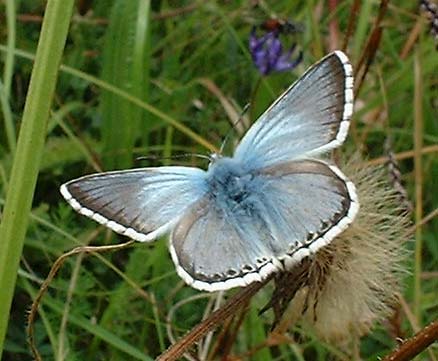 7
August 2000 7
August 2000
Despite
being an overcast day, an impressive number and variety of
Butterflies
fluttered
around the slopes (TQ 212 073)
of Mill Hill.
Flutters
of light blue flicked between the grasses and wild plants: the
Chalkhill Blue,
was
common, only occasionally opening up its wings in the  intermittent
rays of sunshine.
Gatekeeper Butterflies were common;
perhaps, some of these were Meadow Browns.
Cabbage
Whites were more noticeable than their
frequent occurrence. The variety was enhanced by the occasional Painted
Lady, a distinctive unidentified
species, singly,
away from any shade, and
a solitary obliging Marbled
White, that remained stationary and opened
up its wings. There were a small butterflies
as well, perhaps one of the
Skippers. intermittent
rays of sunshine.
Gatekeeper Butterflies were common;
perhaps, some of these were Meadow Browns.
Cabbage
Whites were more noticeable than their
frequent occurrence. The variety was enhanced by the occasional Painted
Lady, a distinctive unidentified
species, singly,
away from any shade, and
a solitary obliging Marbled
White, that remained stationary and opened
up its wings. There were a small butterflies
as well, perhaps one of the
Skippers.
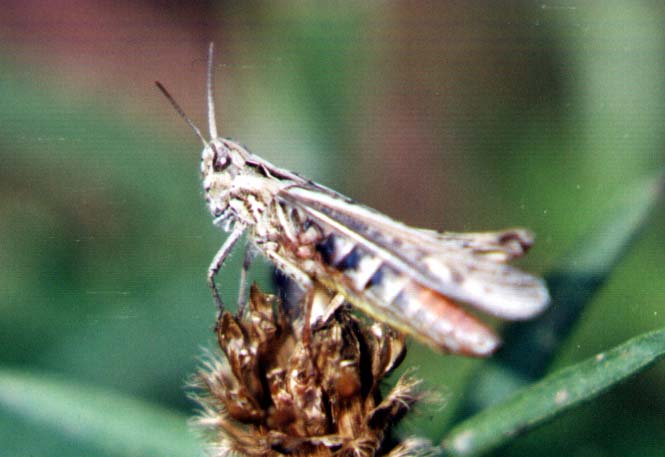
There
were thousands of Grasshoppers
(at least two, possibly three species) in the long grasses.
Butterflies
of Adur (with scientific names)
ACFOR
system of abundance
Ray
Hamblett's Mill Hill & Beeding Hill Page
Captain's
Butterfly Guide
Immigration
of Lepidoptera
Butterfly
Bionomics Information (Really Wild Flowers)
Butterflies
of Ireland (with pics)
Guy
Padfield's European Butterfly Page (with pics)
Butterflies
of Lancing
Mapmate
6 August
2000
Large
Bass,
up to 2 kg, cruised into the entrance of Shoreham Harbour, (TQ
235 048) scattering the shoals ofSand
Smelt,
Atherina
presbyter. The anglers were catching the attractively patterned Sand
Smelt at a length of 16 cm (excluding the caudal fin).
Swarms
of Moon
Jellyfish, Aurelia aurita, are in Shoreham harbour.
A
small pod of Dolphins were spotted near
Hove Lagoon.
2 August
2000
The Adur
Valley eForum covering all aspects of life in the Adur Valley commences.
You can join by spending a few minutes on the following site, and then
you can post messages on almost anything about life in Shoreham-by-sea
and the Adur Valley, including, Lancing, Sompting, Southwick, Steyning
and the smaller villages in the valley. If you have any difficulties logging
on, send an Email to Glaucus@hotmail.com
1 August
2000
 A
most unusual appearance on Kingston
Beach was a solitary Snakelocks
Anemone, which reach their most easterly point of distribution
up the English Channel (northern coast) at Worthing,
with an occasional stragglers on the shore at Shoreham, and almost entirely
absent (one record only in 100+ visits) from Brighton. A
most unusual appearance on Kingston
Beach was a solitary Snakelocks
Anemone, which reach their most easterly point of distribution
up the English Channel (northern coast) at Worthing,
with an occasional stragglers on the shore at Shoreham, and almost entirely
absent (one record only in 100+ visits) from Brighton.
1
August 2000
The Marine
Wildlife Forum of the NE Atlantic commences.
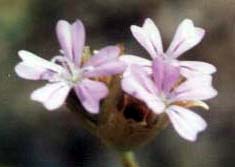 31
July 2000 31
July 2000
A
Clouded
Yellow Butterfly
was spotted on a Childing Pink
still in flower in the minute area of sand dunes
(TQ 229 048) remaining on Shoreham
Beach. These rare plants seem to have increased in number, but are
still under threat from encroaching vegetation.
30
July 2000
Butterflies
The Lancing
chalk pit area in July is washed with the fragrance of Buddleia
davidii, this is possibly the best area
on the Ring for butterfly spotting. On this visit at the end of July there
were good numbers of Speckled Wood,
Gatekeeper
and Meadow Brown. I saw three Commas',
I think two males may have been competing over a female.
Two
Marbled
Whites fluttered in.
26
July 2000
A
shoal
of about 50 adult Grey
Mullet,
Chelon
labrosus, varying in length from 40 cm to 90 cm (excluding the caudal
fin) followed the neap tide in in the shallows of the River Adur on the
southern side outside Emerald Quay (TQ 225 048).
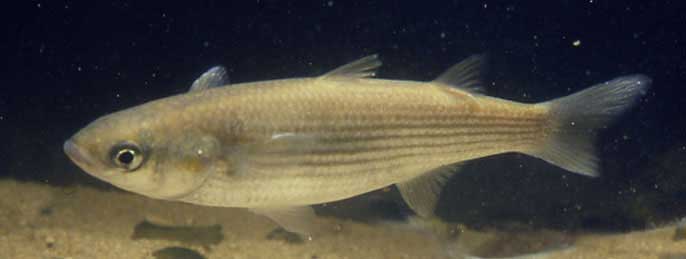
In
between the high density flats, the small weir keeps a depth of water of
just under a metre and makes a huge rock pool trapping up to perhaps half
a dozen Grey Mullet and shoals of hundreds of small (first year) Bass
where they spend the summer. The Bass were "flashing" and the inevitable
Shore
Crabs crawled along the bottom and around the mooring ropes.
21
July 2000
It
was another sunny day, with quite a strong steady breeze. The eastern riverside
walk (TQ 208 054)
from the Toll Bridge south is lined
with Buddleia
and the chalk soil contains grasses,
Red Valerian
and a few meadow plants. However, butterflies
were only a handful of Gatekeeper,
Cabbage
Whites and an occasional Red
Admiral. There were a small butterflies
as well, perhaps one of the Skippers.
On 24 July 2000,
Ray
Hamblett noticed the same paucity of butterflies
upriver near the old Cement Works, although he spotted a solitary Comma.
20
July 2000
The
nearly Full Moon turned an orangey-pink as it rose at
11:30 pm after a bright sunny day, with temperatures at least 25° C.
Tides
Page
 6
July 2000 6
July 2000
A
Common
Emerald Moth, Hemithea aestivaria, entered my house in South
Lancing. The wingspan is about 28 mm. This is the commonest of the emerald
moths, distinguished from the Large Emerald because of its wavy lines.
4
July 2000
The late afternoon saw a brief thunderstorm
and downpour. However, in other parts of Sussex an unprecedented 70 mm
of rain fell in 24 hours. In Shoreham 58 mm of rain was recorded, which
is a large amount.
The
green seaweed
Enteromorpha has covered the mud and sand between the Old Fort
and Soldier's Point, (TQ 233 045),
Shoreham
Beach. This annual seaweed favours area where fresh water and seawater
mix, and its occurrence is likely to have occurred because of the excessive
rainfall in May, and also because the beach was closed last year and the
bait diggers have not returned in their usual numbers.
House
Martins are
nesting in Gordon Road, Shoreham.
1 July
2000
Scores of Moon
Jellyfish Aurelia aurita in Shoreham Harbour, but
they do not appear to be as numerous as in the last two years. The Japweed,
Sargassum
muticum, was particularly abundant on the edges of the bank and empty
wharves opposite the nearly completed new Power Station.
A
day-flying Hummingbird Hawk-moth,
Macroglossum
stellatarum, was reported by S. Nash from Upper Beeding High Street.
Immigration
of Lepidoptera
30
June 2000
Plenty
of Pyramidal
Orchids (TQ 207 067) were easily spotted
on the cycle route from Old Shoreham to Bramber
and on the roadside verges and South Downs way bridlepaths and footpaths
over the Downs. Gatekeeper
and
Red
Admiral butterflies flitted amongst the
variety of wild plants with the occasional
Clouded
Yellow. The Redshanks did not seem to
be present on the
Adur riverbank.
Wild
Flower Society
29
June 2000
On
a sunny day, an unfamiliar yellow butterfly was spotted by Andy
Horton amongst the Tree Mallow
on Lancing beach. It was bright yellow with a dark rim to its wings. I
have identified it as a migrant, the Clouded
Yellow, Colas croceus.

18
June 2000
Ray
Hamblett discovered the a meadow (TQ 208 098)
of
orchids in full flower near Beeding Hill, north
of Mill Hill during the heatwave (temperatures
to 27° C).
Information
& Photographs link (Ray Hamblett's site).
British
Orchid Information (Really Wild Flowers)
ORCHID
SLIDE SHOW (photographs
by Ray Hamblett) (CD-ROM only)
11
June 2000
Martin
Davies surprised aRoe
Deer when cycling between Truleigh Hill and
New Erringham Farm over the downs route
to Mill Hill. It was in the arable field on
the east side near Beeding Hill.
June
Brown has seen deer on the grazing pastures
of the Adur flood plain.

3
June 2000
The
first fine sunny day after one of the wettest Mays on record for the
WORLD
OCEANS DAY
Adur
Exhibition on Coronation Green
World
Oceans Day (Slide Show)
2 June
2000
Kingston
Beach
The
sea anemone Sagartiogeton undatus
was discovered. This uncommon sea anemone is present locally but rarely
found.
Butterfish
were discovered under rocks just above low water mark, and a couple of
Bullheads
were caught near low water mark. Blennies were
common (see below). Large
edible sized prawns
were absent, although present at other locations off Shoreham.
2 June
2000
Flocks
of Jackdaws arrive in the gardens to the north of Shoreham
Town centre in their scores (there are probably hundreds), scavenging
in pairs on the greens adjacent to roads.
30
May 2000
Kingston
Beach fails to comply with the mandatory levels of minimum sewage pollution,
exceeding the coliform count. This is not the EA figures but samples taken
by Adur District Council.
EU
Legal Requirements (link)
16
May 2000
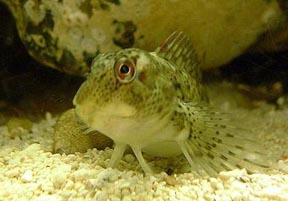 Two
consecutive days start off misty with the new Power Station chimney completely
obscured from Shoreham and the fog horn sounding. Approaching the low springs,
(high at 5.6 m, low at 1.2 m), Blennies
(a small green fish) were exceptionally common at Kingston
Beach, below low water mark, commoner than for any time for 20 years.
They varied in length from 60-75 mm long. Apart from a few Common
Gobies, they were the only fish in the pools. Two
consecutive days start off misty with the new Power Station chimney completely
obscured from Shoreham and the fog horn sounding. Approaching the low springs,
(high at 5.6 m, low at 1.2 m), Blennies
(a small green fish) were exceptionally common at Kingston
Beach, below low water mark, commoner than for any time for 20 years.
They varied in length from 60-75 mm long. Apart from a few Common
Gobies, they were the only fish in the pools.
Shore
Crabs were plentiful as is usual in May, but what was surprising was
that almost 100% of them were coloured green.
1999
Report
Tides
page
10
May 2000
Hedgehogs
mate, snorting noisily, amongst the docks and bluebells in Corbyn Crescent
(TQ
224 053). The thunderstorms forecast seem
to have avoided Shoreham. It is sunny and humid and large Black Slugs,
Arion
ater, 15 cm long, venture out in the damp atmosphere.

Lancing
Clump Photographs (May 2000) by Ray Hamblett (Link)
20
April 2000
Continual
rain all day long. When will it ever stop?
14
April 2000
A
number of Skylarks were airborne over Lancing Clump.
Link
to the Full Wildlife Report from Ray Hamblett
10
April 2000
A
second successive sunny day with a north-east wind. In a mild winter, sunny
days have been few and far between. A Weasel, Mustela nivalis,
was seen successfully crossing the busy four-lane A27 main south coast
road near the Sussex Pad.
The
Old Fort sea defences on the River Adur side have been extensively repaired and re-landscaped. a solitary Brent Goose, seen before at this location
in spring, foraged along the incoming tide line. Its previous foraging
zone has been been replaced by lumps of a hard granite-like rock from Norway.
Both near the Shoreham Harbour piers and between the Shoreham Motor Yacht
Club and the beach, the gravel has been extensively shifted around obliterating
the shingle plants, especially Sea
Campion, and Yellow-horned
Poppy.
and re-landscaped. a solitary Brent Goose, seen before at this location
in spring, foraged along the incoming tide line. Its previous foraging
zone has been been replaced by lumps of a hard granite-like rock from Norway.
Both near the Shoreham Harbour piers and between the Shoreham Motor Yacht
Club and the beach, the gravel has been extensively shifted around obliterating
the shingle plants, especially Sea
Campion, and Yellow-horned
Poppy.
More
on the Old Fort changes
27
March 2000
Hundreds
of Black-headed Gulls
on the mudflats each side of the Toll
Bridge, but there are no sign of the flocks of Lapwings
on the airfield or the Adur.
23
March 2000
Upper
Beeding Parish Councillors have complained that wildlife (wading birds)
have been driven away by the draining of the Upper Beeding Brooks
by the Environmental Agency to prevent flooding.
March
2000
Jays
have visited Windlesham Gardens (a road) on several occasions during February
and March. A Grey Heron visited a large pond in a large town garden
just off the town centre, and Herring Gulls look like making a nest
on the rooftops.
Report by Alan
6 March
2000
On
an overcast day, thousands of Black-headed
Gulls, many more than usual, congregated
on the River Adur at high tide, with more in the fields and flying over
Shoreham Town Centre. A few Chaffinches,
no longer common, showed a preference for a Pussy Willow Tree near
the Waterworks Road. I disturbed a Pheasant
on
the flood plain fields grazed by a flock of sheep.
4 March
2000
The
garden ponds in Shoreham, complete with frog spawn froze over during the
night.
3 March
2000
First
reading of the Countryside & Rights of Way Bill.
More
Information Link
1 March
2000
A
couple of Moorhens
scrambled about in the muddy field called Longacres
underneath the Adur Flyover and a Heron
patrolled along the drainage streams on the edge of the nearby grazed fields,
looking for frogs. There was no sign of frog spawn.
29
February 2000
South-westerly
gales and rain sweep the whole of the British Isles. Although the south-east
of England escaped relatively lightly (12 mm of rain), it was extremely
unpleasant to venture out, and the conditions were sufficiently windy to
make cycling impossible for the whole of the morning.
27
February 2000
Gallons
of Frog Spawn
laid in the Hamme Field allotments, Shoreham. (58 days after the start
of the Millennium).
Report
by Joan Barker
24
February 2000
The
patch of Glasswort, Salicornia
europea,
that burst into life last year has had a lasting effect. Glasswort is an
annual plant. However, the growths were accompanied by a mat of green algae
and this can been seen clearly from the footbridge. Oystercatchers
were the most noticeable bird probing with their long red bills where the
algal mat meets the mud. Dunlins numbered about a dozen that come
be seen clearly without binoculars from the footbridge at mid-tide level,
and there were plenty of Black-headed Gulls
and a few Redshanks.
Glasswort
is the first colonising plant nearest the low tide mark.
Verdant
Mud 1999
11
February 2000
At
least a dozen Collared Doves
visited St. Mary's Churchyard, Shoreham, after a spell of windy weather.
They seem to favour the conifers in the churchyard.
11
February 2000
Murmurations
The
male Starling,
with an iridescent blue band underneath its neck, called out to its mate
from every conceivable vantage point. Throughout Shoreham it seems that
there is scarcely a chimney pot or a tree with one and often more of the
birds calling out with a mixture of clicks and chirrups and weird noises
(like a telephone off its hook). The tens of thousands of Starlings exceed
previous years. About 50 could be seen in a single town tree.
10
February 2000
The
morning gales and high tide congregated hundreds of omnipresent Black-headed
Gulls on the shingle, a common event.
However, I noticed that scores of these gulls had very dark red legs, as
dark as the Mediterranean Gull. Heads varied from all brown (looks black
in the winter light) to patchy and all white.
On
the brackish Widewater Lagoon, Mute Swans
drunk from a bowl of fresh water provided for them.
9 February
2000
Red-breasted
Mergansers rested
on Widewater
after a squally spell of rain and high winds gusting to gale force.
4 February
2000
With
the weather clement for early February, but the days still short, so it
remains dark for the low springs when the mussel beds are revealed by the
ebbing tide, a solitary Oystercatcher,
amongst
the Black-headed Gulls,
foraged
at dusk. I thought just for one moment the Oystercatcher was stabbing at
the mussels, but it wasn't, merely probing between the shells of crabs
and worms.
26
January 2000
After
a sub-zero night, the bright sun throughout the day still left patches
frost on the riverbank in the late afternoon. The flood River
Adur was still as a millpond and the sun low in the sky cast strong
reflections. Lapwings
foraged in their thousands on the airfield. As usual in January, Redshanks,
hunted amongst the Sea Purslane
in the river shallows.
24
January 2000
Anybody
notice the screeching sound that a Starling
makes? I thought I had left the telephone of the hook (is it mimicking
the sound?), but a Starling
was standing on the wire outside the window, communicating with other Starlings
of the huge flocks that disperse in the morning and congregate again for
their night roosts.
21
January 2000
Little
Grebes were diving under water for fish
north of the Toll Bridge. These birds appear to have been absent for a
few years.
21
January 2000
The
Lunar
Eclipse is obscured by low misty cloud. The Moon was meant to look
orangey (the Earth's atmosphere acting like a prism for the rays of the
Sun).
http://spacescience.com/headlines/y2000/ast02feb_1.htm
18
January 2000
Adur
Quality of Life meeting (click on the text for a summary)
15
January 2000
Foxes
are making a nuisance of themselves on Shoreham beach near the Old Fort.
They are very noisy at night with territorial fights, and are also visible
in daytime. One passed our gate at 9.00 am and returned at 11.30
am, walking from the beach, through our garden, across the road and through
the garden opposite.
Later
a neighbour telephoned me to inquire what could be done about them, as
they are becoming a nuisance, digging up bulbs, and damaging garden plants.
ADUR
NATURE NOTES 1999
|


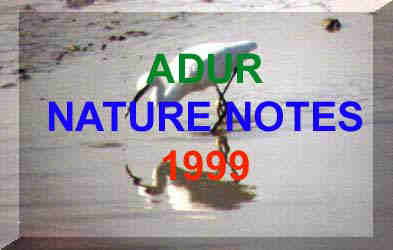

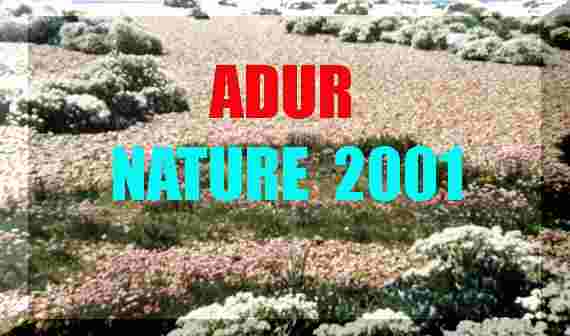











 Under
the dark Beech canopy of Lancing Clump, Speckled
Wood Butterflies (
Under
the dark Beech canopy of Lancing Clump, Speckled
Wood Butterflies ( 20
August 2000
20
August 2000



 31
July 2000
31
July 2000





 and re-landscaped. a solitary Brent Goose, seen before at this location
in spring, foraged along the incoming tide line. Its previous foraging
zone has been been replaced by lumps of a hard granite-like rock from Norway.
Both near the Shoreham Harbour piers and between the Shoreham Motor Yacht
Club and the beach, the gravel has been extensively shifted around obliterating
the
and re-landscaped. a solitary Brent Goose, seen before at this location
in spring, foraged along the incoming tide line. Its previous foraging
zone has been been replaced by lumps of a hard granite-like rock from Norway.
Both near the Shoreham Harbour piers and between the Shoreham Motor Yacht
Club and the beach, the gravel has been extensively shifted around obliterating
the